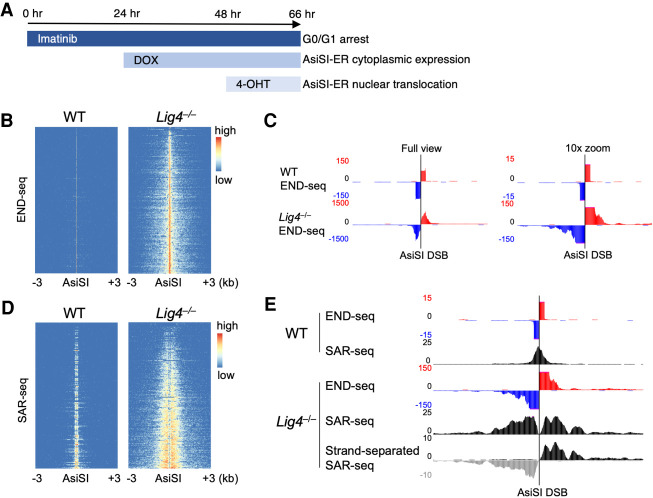Figure 1.
Resected 3′ overhangs undergo extensive DNA synthesis. (A) Inducing AsiSI restriction enzyme breaks in Abelson-transformed murine pre-B cells. Cycling cells were arrested in G0/G1 for 24 h with the Abelson kinase inhibitor imatinib, followed by 24 h of doxycycline (DOX) to express AsiSI fused to estrogen receptor (AsiSI-ER). Double-strand breaks were synchronously induced by 4-hydroxytamoxifen (4-OHT) that translocated AsiSI-ER into the nucleus. (B) Heat maps of END-seq signal ±3 kb around the strongest (i.e., the most signficant and reproducible) 200 AsiSI cut sites, ordered by total read count, for WT and Lig4−/− cells after 18 h AsiSI induction in which extensive resection is observed in Lig4−/−. (C) Genome browser snapshot of strand-separated END-seq reads at a single AsiSI location (chr9: 121,477,509–121,477, 517), either at full view in Y-axis read intensity (left) or zoomed in 10-fold (right) to better view distal resection reads. (Red) Positive strand, (blue) negative strand. (D) Heat maps of localized DNA synthesis as detected by SAR-seq ±3 kb around AsiSI cut sites in WT and Lig4−/−cells after 18 h AsiSI induction. (E) Genome browser snapshot of WT and Lig4−/− END-seq and SAR-seq at a single AsiSI location (chr9: 121,477,509–121,477,517). (Bottom) A modification to the SAR-seq protocol in which only EdU-incorporated DNA strands are sequenced (“strand-separated SAR-seq”) shows that DNA synthesis occurs exclusively on resected 3′ overhangs. All panels show representative data sets from two independent replicate experiments.

